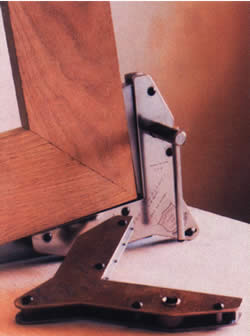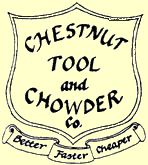(1-800-966-4837 )
P.O. Box 812
Holden, Maine 04429
![]()
Index of Videos
No Fees, No Cookies,
No Registration
1 more new
Sept. 24, '06
Clam
Clamp Miter Clamps
for
Perfect Miters ...... Fast
Clamp Review
#3
Reprinted from "Fine Homebuilding" magazine
, September 1996
Issue 104, page 108
Miter clamps for
interior trim

Regular
readers of Fine Homebuilding probably recognize Jim Chestnut
as a frequent contributor. When I heard that he had designed miter clamps
for trim work, I wanted to try them.
Clam Clamps, as Chestnut calls them,
consist of two steel bars sandwiched between L-shaped nickel-plated
steel plates (P.O. Box 320094, Fairfield, Conn. 06825; 800-966-4837
to order, 203-384-0888 for more information). Each bar holds four setscrew
pins ground to a point for gripping the stock. One bar is fixed, and
the other is spring-loaded against a cam. After the clamp is placed
against the trim pieces, the cam's handle is turned, drawing mitered
pieces together evenly.
The clamps come in two models, one with
an integral handle and one that accepts
a 3/8-in. square-drive ratchet wrench.
Once the clamp
has been tightened, the wrench can be removed. The clamp maintains its
pressure. This allows prefabricated trim units (such as a set of door
or window casings) to be stored in a small space until the units are ready
for installation.
Fine-tuning the clamps' action is
accomplished by threading the pins in or out, and by sliding the cam's
adjustable pivot to concentrate force at the heel or toe of the joint.
So far, so good: clamps that are powerful,
efficient, well-made and durable. But because there are other clamps out
there that can do similar things with miter joints, you might balk at
their price -$55 each-especially if you don't know what they're really
for.
Chestnut, a finish-carpentry contractor
for the past 20 years or so, has developed an elegant system for installing
high-quality trim work on a production basis, and these clamps are at
the heart of that system. By this method, side and head casings are measured,
mitered and slotted for biscuits, then glued, splined and clamped. Fabrication
can be done on a
simple, job-site
worktable, made
from a Formica-covered sheet of plywood mounted on sawhorses.
This technique accomplishes several
good things: Because the work is done off the floor, it's easier to
do accurately; splined, glued
and clamped, the casings joints are far less likely to open over time;
and the pieces are far more likely to wind up in the same plane on the
wall (eliminating much finicky fitting). Accurately made up, a prefabricated
trim unit can double as its own squaring jig at installation.
Obviously, avoiding bottlenecks
is crucial to any production technique, and Clam Clamps are powerful
enough to secure casing assemblies while they're moved to make room
for the next, and unobtrusive enough to leave on during installation.
This makes glue-curing downtime a function of the number of clamps at
hand. Chestnut estimates that four or even five pair of these clamps
would be necessary for ultimate efficiency, and that's a lot of dough.
But for those who believe that organization pays, these tools, especially
when used as recommended , are a winning proposition.
--Michael Standish, a carpenter in Jamaica Plain, Massachusetts.
